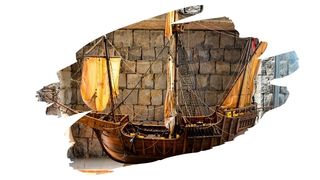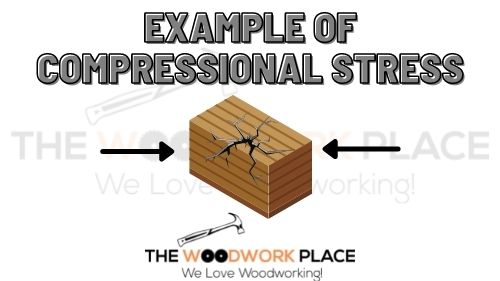Do you want a lightweight model glue that’ll dry in seconds? Then cross wood glue off your list.
Sure, wood glues are incredibly strong. It’s one of the reasons why this PVA-based adhesive is so ideal for creating durable glue joints.
But, this fairly slow-drying glue is going to make life frustrating, when it comes to building your model ship.
So, in this post, we dive into why wood glues form such strong glue joints. You’ll also learn why wood glue aren’t the most suitable adhesive for a lightweight wooden ship model.
And keep reading to discover which super-fast drying glue is the best adhesive for your wooden ship.

This post may contain affiliate links to products that we receive a commission for (at no additional cost to you). Learn more here.
Does Wood Glue Work On Wooden Ship Models?
Whether you’ve used Balsa, Maple, or even Paulownia wood, to make your ship, wood glue can bind them all tightly.
However, when it comes to model making, using an adhesive that actually sticks is the least of your worries. You’re bigger concerns are weight and drying speed. You see…
…Wood Glues Are Only Good For Gluing Wood
If any part of your model plan involves sticking wood onto plastic, or vice versa, a wood glue won’t hold.
Wood glues, (also known as carpenter glue), are PVA (Polyvinyl Acetate) adhesives. These slow-drying glues are superb at binding lumber, and other wood-derivative materials such as paper. Yet, they fail at getting plastics or metal to stick to anything.
A wholly wooden model ship should be fine with wood glue alone. Any metal fittings that require adhesives, however, will need to be affixed using something else.
…Wood Glues Add A Fair Bit Of Weight To Lightweight Wood
A good wood glue works by sinking into wood grain. That way, it can bind two pieces of wood together right down to their wood fibers.
But, as a relatively thick adhesive, this also means that glue will add weight to a model kit. Especially if you use a liberal amount of glue across every section of that model ship.
…Wood Glues Take A Long Time To Dry (For An Adhesive)
PVA wood glues need 30 minutes to dry and hold. However, they need up to 24 hours to cure and set permanently.
Now, when it comes to woodworking in general, this isn’t a problem for the most part. That’s because you can use clamps or nails to hold things in place as you wait for glue to dry.
But neither one of those options, (either clamps or fine nails), are suitable for a delicate ship model. So, that means you will be left holding things in place manually for a good half an hour.
Related Post: What Woodworking Clamps Do I Really Need? (A Beginners Guide)
So, What Glue Should You Use For Model Ships?
To save yourself time, use CA (Cyanoacrylates) glue.
Also known as super-glue, this fast-drying adhesive can dry in as little as 10 seconds. And it only needs 8 or so hours to completely cure and set.
What’s more, this super solution can bind wood, plastic and even metal with ease. This is all thanks to its key high strength bonding ingredient, Cyanoacrylates.
Is CA Glue The Same Thing As Wood Glue?
No, they are two very different substances. PVA wood glues are made from thermoplastics. While CA super glues contain formaldehyde condensation.
This difference allows CA glue to cure and set in a third of the time of PVA glue.
Why Would Anyone Use Wood Glue At All If CA Glue Is Quicker To Dry?
Wood glues are better for general woodworking, because they are stronger than CA.
You see, once CA glue cures and sets, it is a fairly brittle substance. It can snap under everyday handling, wear and tear.
On the other hand, wood glues are much more durable. And once this adhesive sets, it solidifies into a substance made of stronger stuff than the very wood it’s glue to.
In other words, wood glues have much more compressional strength than CA glues. That’s why when you make large wooden pieces — especially ones that undergo a lot of impact force, such as cutting boards — you should use wood glue.
However, when it comes to small scale models, compressional strength isn’t as much of an issue. In which case, CA glue is a perfectly good adhesive to use.
And Just What Is Compressional Strength?
Compressional strength measures how much compressional stress a solid substance can take, before it collapses in on itself.

Wood types that have high compressional strength are stronger, more durable, and tough.
With wood specifically, we measure this materials compressional strength using something called the Janka scale. The higher the Janka rating of a piece of wood, the greater it’s compressional strength will be.
What About Weight? Will CA Glue Add A Lot Of Weight To My Ship Model?
The only way to keep added glue wait to a minimum, is to make sure you only apply very thin applications of it. This is true of any type of adhesive you use on your model.
So, when you apply it, do so with a light touch. And then afterward, press the two glued pieces together. This will squeeze as much of the excess glue out the sides as possible, and get rid of any gaps.
To Wrap Up, Here Are The 3 Key Takeaways From This Post…
- 1). Wood glue, (also referred to as PVA glue), is strong enough to stick two pieces of wood together. It will not, however, be enough to glue any plastic or metal fittings.
- 2). CA glue (or more popularly known as Super Glue), is strong enough to bind wood, plastic and metal. What’s more, it dries and cures in a fraction of the time of wood glues.
- 3). CA glues dry faster, but they are a more brittle adhesive than PVA glue (once they’ve set). So, CA glue is only suitable for very lightweight model wood crafts.
References:
Ethyl Cyanoacrylates | Wikipedia.org


